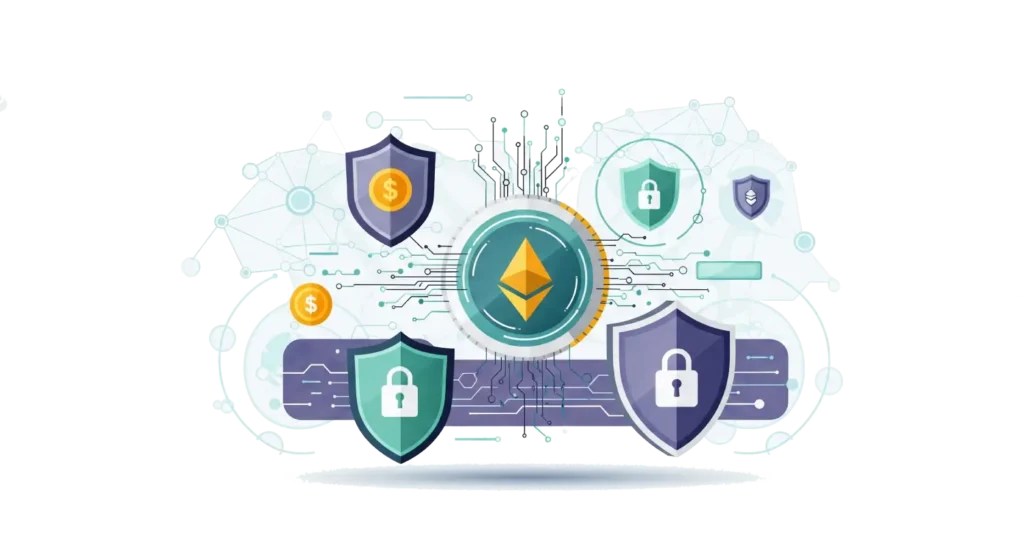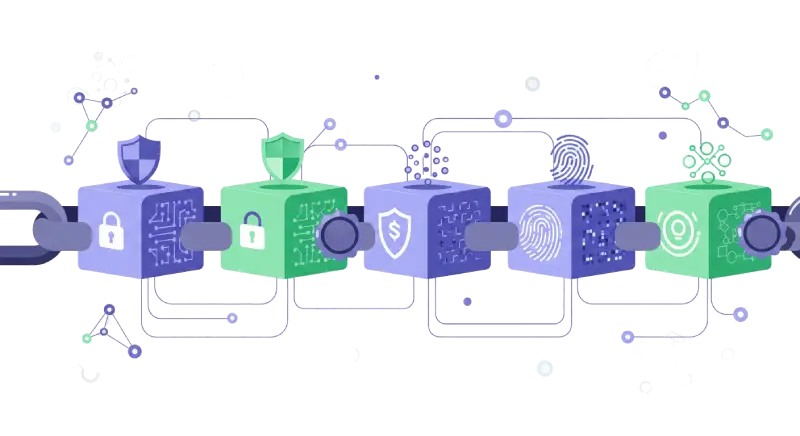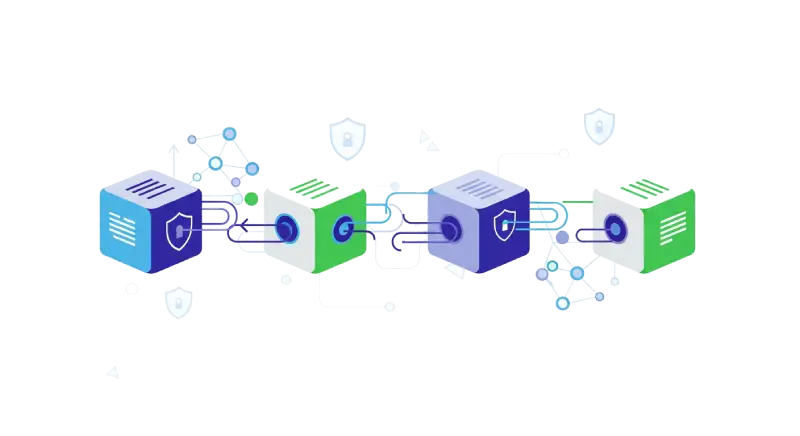
Why Understanding Crypto Security Matters?
Your crypto is like digital gold 💰. But there’s no bank to protect it. If your digital assets are stolen, they are often gone forever.
This brings up key questions: What is crypto security? It also makes people ask, What does crypto security mean? And many wonder, Who owns crypto? Plus, Can crypto crash to zero?
Understanding these points is not just important—it’s everything. It’s about protecting your digital wealth and navigating this new financial world. ✨
📌 Key Takeaways
- ✅ Self-Responsibility: You are your own bank in crypto. There’s no central authority to help if things go wrong.
- ✅ Digital Keys are King: Your private keys are the ultimate control over your crypto. Keeping them secret is vital.
- ✅ Technology is the Shield: Crypto security relies on complex computer science like cryptography and blockchain.
- ✅ Threats are Real: Bad actors constantly try to steal crypto through various tricks and attacks.
- ✅ Value vs. Security: Losing crypto value due to market changes is different from losing it to a hack.
1. What Does Crypto Security Mean?
Crypto security is all about keeping your digital money safe. It also protects your secret information, like private keys.
The main goal is to stop anyone else from getting to your crypto. Think of it as a strong lock on your digital wallet. 🔒
More Than Just Theft Prevention
Crypto security goes beyond just stopping thieves. It also protects against accidental loss. For example, if you lose your private key, your crypto is gone forever. There is no “reset password” button. 🤯
It also aims to prevent issues from technical failures. Sometimes, software can have bugs. Good crypto security helps reduce these risks. It keeps your digital assets available only to you.
Your Role as Your Own Bank
In the crypto world, you are your own bank. This means you have full control over your money. But it also means you have full responsibility for its safety. 💪
Crypto security helps you manage this big responsibility. It involves understanding how the system works. It also involves making smart choices.
It’s a mix of advanced computer science and good personal habits. Every action you take can affect the safety of your digital wealth. 🧠
2. Core Crypto Security Technologies
Crypto security relies on a few core ideas. These ideas work together. They form the strong foundation of a secure digital system. 🏗️
2.1. Private and Public Keys 🔑
Your crypto wallet has two special codes. They are mathematically linked.
- Public Key: This is like your bank account number. You can share it with anyone. Others use it to send you crypto. It’s safe to give out.
- Private Key: This is like your secret password or PIN. It lets you access and spend your crypto. You must keep it absolutely secret! If someone gets your private key, they can steal your funds. 😱
Think of it this way: your public key is your address on the internet. Your private key is the special key to your digital safe. Only with the private key can you open the safe and move your money.
Sometimes, you hear about a Seed Phrase (also called a recovery phrase). This is a list of 12 or 24 simple words. This phrase is a human-readable form of your private key. It can generate all your private keys. It’s the master key to your entire wallet. Losing it means losing access to your crypto forever. 💀
2.2. Cryptography 🔐
This is the science of secret codes. It’s the backbone of all crypto security.
- Securing Messages: Cryptography turns your transactions and data into unreadable messages. This is called encryption. Only someone with the correct key can unlock and read them. This keeps your information private.
- Ensuring Integrity: It also makes sure data hasn’t been changed. If even a tiny part of a message is altered, cryptography will detect it.
- Digital Signatures: When you send crypto, you “sign” the transaction with your private key. This creates a unique digital signature. This signature proves that you sent the transaction. It also shows that the transaction has not been tampered with. It’s like your personal, unforgeable stamp. ✅
2.3. Hash Functions 📝
Imagine taking any amount of information – a single word or a whole library – and turning it into a short, unique fingerprint. That’s what a hash function does.
- Unique Fingerprint: It takes any data and creates a fixed-size code. This code is called a “hash.”
- One-Way Process: You can easily create a hash from data. But you cannot go back from the hash to the original data. This makes it very secure.
- Detecting Changes: If even one tiny thing changes in the original data, the hash (fingerprint) changes completely. This helps quickly check if data has been tampered with. It ensures data integrity.
In blockchain, hash functions link blocks together. Each new block includes the hash of the previous block. This creates a chain that is very hard to break or alter. ⛓️
2.4. Blockchain Technology 🔗
This is a special type of digital record book. It’s not stored in one place. Instead, it’s spread across many computers around the world.
- Decentralization: The blockchain is not controlled by any single company or government. Many different computers (nodes) hold a copy of the entire record. This makes it very strong against attacks. If one computer goes down, the others keep the network running. There’s no single point of failure. 🌐
- Immutability: Once a transaction or piece of information is recorded on the blockchain, it’s very hard to change or remove. It’s permanent. This is because each block is linked to the previous one using hashes. Changing one block would require changing all the blocks after it, which is nearly impossible on a large network. This creates a trustworthy and unchangeable history. For a deeper dive into its protective features, explore What Makes Blockchain Secure?
- Transparency: All transactions on the blockchain are public. Anyone can view them. However, the identities of the people making transactions are usually hidden (pseudonymous). This transparency helps ensure that the system is fair and honest. Everyone can see what’s happening. 👀
- Consensus Mechanisms: Blockchains use special rules to agree on new blocks. For example, Bitcoin uses “Proof of Work.” This means computers solve complex puzzles to add new blocks. This process makes the network secure and ensures everyone agrees on the correct history of transactions. This agreement is vital for security.
📚 Related Reading: To learn more about how this technology works, read our article: What Is Blockchain and How Does It Work?
3. Common Threats to Crypto Security
Even with strong technology, dangers exist in the crypto world. Bad actors are always trying to steal crypto. Understanding these threats helps you grasp the risks involved. 🚨
3.1. Phishing 🎣
Phishing is a common trick. It’s when attackers pretend to be someone you trust. They might act like a crypto exchange, a wallet provider, or a well-known person.
- Fake Websites: They create fake websites that look real. These sites might ask for your private keys or login details. Always check the website address very carefully. Even a tiny spelling mistake can be a sign of a fake site.
- Fake Emails/Messages: They send emails or messages. These might say your account is in danger. Or they might offer a fake giveaway. Their goal is to make you click a bad link. Clicking it can lead to your crypto being stolen.
- Urgency and Fear: Phishing messages often create a sense of urgency. They might say “Act now or lose your funds!” This makes people panic and make mistakes.
3.2. Malware 🦠
Malware is short for “malicious software.” It’s bad computer code designed to harm your device or steal information.
- Keyloggers: This type of malware records everything you type. It can capture your passwords and private keys as you enter them.
- Clipboard Hijackers: When you copy a crypto address, this malware changes it. It replaces the correct address with the attacker’s address. So, when you paste and send crypto, it goes to the thief instead of your intended recipient. 😲
- Ransomware: This malware locks your computer or encrypts your files. It then demands crypto as payment to unlock them. If you don’t pay, you might lose access to your data forever.
- Wallet Stealers: Some malware specifically looks for crypto wallet files on your computer. If found, it tries to copy them and send them to the attacker.
Always use good antivirus software. Be careful about downloading files from unknown sources.
3.3. 51% Attacks 📊
This is a theoretical risk for some blockchains. It’s more likely to affect smaller, less secure networks.
- Controlling Power: It happens if one group or person controls more than half (51% or more) of a blockchain’s computing power. This power is used to confirm transactions.
- Double-Spending: With this much power, the attacker could try to “double-spend” their crypto. This means they spend the same crypto twice. First, they send it to someone. Then, they use their power to rewrite the blockchain history. They remove the first transaction and send the same crypto to themselves.
- Difficulty for Large Blockchains: For very large blockchains like Bitcoin or Ethereum, a 51% attack is extremely difficult and expensive to carry out. The amount of computing power needed is huge. It’s often not worth the cost for an attacker.
3.4. Social Engineering 🗣️
This is about tricking people, not computers. Attackers use psychological tricks to make you give up information or access.
- Impersonation: They might pretend to be customer support, a friend, or an important figure. They gain your trust. Then they ask for sensitive details.
- Fake Giveaways/Airdrops: They might announce fake crypto giveaways. They ask you to send a small amount of crypto first to “verify” your wallet. But you never get anything back.
- Emotional Manipulation: They might create a sense of urgency, fear, or greed. For example, “Your account is locked, click here immediately!” or “Invest now for guaranteed 100x profit!”
- Baiting: They might leave infected USB drives in public places. Or offer free software that contains malware. When you use it, your device gets infected.
Never share your private keys or seed phrase with anyone, no matter what they promise.
3.5. Smart Contract Vulnerabilities 🐛
Smart contracts are computer programs. They run on the blockchain. They automatically execute agreements when certain conditions are met.
- Code is Law: The code of a smart contract is “law.” Whatever the code says, happens. There’s no human to stop it.
- Bugs and Flaws: If the code has a mistake or a “bug,” attackers can find it. They can then exploit this bug. This can lead to funds being stolen from the contract. It can also cause the contract to behave in unexpected ways.
- Audits: Many projects have their smart contracts “audited.” This means experts check the code for bugs. But even audited contracts can sometimes have hidden flaws.
Famous hacks like the DAO hack happened because of smart contract vulnerabilities.
3.6. Exchange Vulnerabilities 🏦
Centralized crypto exchanges are platforms where you can buy, sell, and trade crypto. They hold a lot of user funds.
- Centralized Target: Because they hold so much crypto, exchanges are big targets for hackers. They are a “single point of failure.” If an exchange’s security is weak, hackers can steal millions.
- Inside Threats: Sometimes, the threat can come from inside the exchange. A dishonest employee might steal funds.
- Regulatory Risks: Exchanges are often subject to government rules. New rules or bans in certain countries can affect your access to funds on that exchange.
- Trust Required: When you keep crypto on an exchange, you trust that company. You trust them to keep your funds safe. You trust them not to run away with your money. This is different from holding your own private keys.
📚 Related Reading: To learn how to pick a reliable platform, see our guide: How to Choose the Right Crypto Exchange for You.
4. Crypto Ownership & Value Risk
When you own crypto, it’s a bit different from owning money in a traditional bank. It’s very important to understand who truly controls your digital assets. Also, you need to grasp risks that go beyond just theft or hacking. 🧐
4.1. Who Truly Owns Your Crypto? 🙋
This is one of the most fundamental questions in the crypto world. The answer depends on where your crypto is stored.
- 🔑 Your Keys, Your Crypto:
- ➡️ Direct Control: If you hold your own private keys, you are the true owner of your crypto. Your digital assets are stored in a wallet that only you control. This is called “self-custody.”
- 🛡️ Full Responsibility: With self-custody, you have complete power over your funds. You can send them anywhere, anytime. But this also means you are fully responsible for their safety. If you lose your private keys, your crypto is gone forever. There’s no customer service to help you. 🆘
- ✅ No Middleman: This method removes the need to trust a third party. You don’t have to worry about a bank or exchange getting hacked or going out of business.
- 🏦 Exchange Holds Keys:
- 🤝 Third-Party Custody: If your crypto is on a centralized exchange (like Binance or Coinbase), the exchange holds the private keys. You don’t directly control your crypto. Instead, you have an “IOU” (I Owe You) from the exchange.
- 🤝 Trust Required: You trust the exchange to keep your funds safe. You trust them to let you withdraw your crypto when you want. This is similar to how a bank holds your money.
- ⚠️ Risks Involved: If the exchange gets hacked, goes bankrupt, or faces legal issues, your crypto could be at risk. You might lose access to it, or even lose it completely. 📉 This is why the saying “not your keys, not your crypto” is very popular. It highlights the risk of trusting a third party with your digital assets.
📚 Related Reading: To understand more about this, read our article on Custodial vs Non-Custodial Wallets – What’s the Difference?
4.2. Can Crypto Value Go to Zero? 📉
This is a common concern, but it’s important to understand that this risk is about value, not about security breaches like theft.
- 🎢 Market Volatility:
- ⬆️⬇️ Price Swings: Crypto prices can change very quickly and dramatically. They can go up a lot in a short time, and also fall a lot. This is called “volatility.” It’s a normal part of crypto markets.
- 📊 Factors Affecting Price: Many things can make prices change. These include news, government regulations, how many people are buying or selling, and overall economic conditions. 📰
- 🚫 Not a Security Issue: If the price of a crypto drops, it doesn’t mean your crypto was stolen or hacked. It just means its market value has decreased. Your crypto is still in your wallet, but it’s worth less money. 💸
- 🚧 Project Failure:
- 💡 Underlying Project: Every cryptocurrency is part of a larger project. This project has a team, technology, and a goal.
- 🛑 Risk of Failure: A specific crypto project could fail. This might happen for many reasons. For example, its technology might not work as promised. Or, people might lose interest in it. There could be strong competition from other projects.
- 🗑️ Value Loss: If a project fails, the value of its cryptocurrency could drop very low, even to zero. This means the crypto you hold becomes worthless.
- ⚖️ Different from Theft: Again, this is not a security breach where someone steals your crypto. It’s a risk related to the project’s success and market demand. Your crypto isn’t stolen; it simply loses its value. It’s like buying shares in a company that then goes bankrupt. 🏢➡️👻
🎯 Conclusion: Empowering Your Crypto Journey
So, what is crypto security? 🤔 This article has been your guide to understanding its fundamental landscape. We’ve explored the essential technologies that protect digital money and uncovered the common threats lurking in the digital space.
You now have a clearer picture of:
- 💡 The Core Mechanics: How private keys, cryptography, and blockchain form the secure backbone of crypto.
- ⚠️ The Hidden Dangers: Recognizing phishing, malware, and social engineering to avoid common traps.
- 🤝 True Ownership: Understanding the critical difference between self-custody and relying on exchanges.
- 📉 Market Realities: Distinguishing between security risks and the natural volatility of crypto prices.
Grasping these concepts is your vital first step. It empowers you to navigate the exciting, yet complex, world of digital assets with greater confidence and awareness. 🗺️
This foundational knowledge is crucial. It prepares you to make smarter decisions and better protect your digital wealth. 🧠
Ready to take your crypto security to the next level? In our next article, we dive deeper into the best practices and tools to keep your digital assets secure. Check out What is the Best Crypto Security? to learn how to build a robust defense for your crypto journey. Stay tuned for more! 🚀

